 Facebook
Facebook
 X
X
 Instagram
Instagram
 TikTok
TikTok
 Youtube
Youtube

When the table next to us were told they couldn’t order rice, they decided to leave. “What kind of Chinese restaurant doesn’t serve rice?” they muttered on the way out.
The short answer is: duh, a noodle spot.
The longer answer involves recognizing that Chinese food is not a monolithic cuisine, and that while they do grow and eat a lot of rice in southern China, the northern parts of the vast nation, such as Shanxi province, historically developed dishes around a different grain: wheat.
We visited this Convoy Street restaurant, Shan Xi Magic Kitchen, because it keeps alive the tradition of making noodles by hand. It also offers meat skewers, dumplings, and stir fries, but through a window into its kitchen, diners may watch chefs diligently kneading dough to make noodles, both for soups and plated fare.

What particularly drew me in this day is a menu featuring both hand-pulled and hand-ripped noodles.
It took watching a internet videos to understand the basic difference. Each process begins with a lot of kneading and rolling dough until it’s super stretchy. For hand-pulled noodles, it’s rolled into a long, thin noodle that’s pulled into a longer, thinner noodle. That’s folded in half and pulled again into two noodles. Then again into four noodles, then eight, until the original noodle has been stretched and folded into a full serving of dense noodles.
For hand-ripped noodles, the dough is rolled flat, then stretched into a long flat ribbon. That ribbon gets ripped lengthwise to make wide, flat noodles.
We tried the hand-pulled noodles with a sautéed cumin beef ($9.99). They were about the thickness of udon noodles, but more dense with irregular shape. Their exquisite chewiness was the star of the fragrantly spiced dish.
For hand-ripped, we selected “spicy hot oil seared” noodles with stewed pork ($9.59). The wider noodles were softer and less dense, a bit slippery in light oil and chili flakes. The pork had wonderful tenderness, but needed more flavor. I added more chili oil.
With all of Kearny Mesa at their disposal, those customers who left probably found plenty of rice dishes to choose from, probably with more richly flavored food than Shan Xi Magic Kitchen. But if you ask me, they still missed out.


When the table next to us were told they couldn’t order rice, they decided to leave. “What kind of Chinese restaurant doesn’t serve rice?” they muttered on the way out.
The short answer is: duh, a noodle spot.
The longer answer involves recognizing that Chinese food is not a monolithic cuisine, and that while they do grow and eat a lot of rice in southern China, the northern parts of the vast nation, such as Shanxi province, historically developed dishes around a different grain: wheat.
We visited this Convoy Street restaurant, Shan Xi Magic Kitchen, because it keeps alive the tradition of making noodles by hand. It also offers meat skewers, dumplings, and stir fries, but through a window into its kitchen, diners may watch chefs diligently kneading dough to make noodles, both for soups and plated fare.

What particularly drew me in this day is a menu featuring both hand-pulled and hand-ripped noodles.
It took watching a internet videos to understand the basic difference. Each process begins with a lot of kneading and rolling dough until it’s super stretchy. For hand-pulled noodles, it’s rolled into a long, thin noodle that’s pulled into a longer, thinner noodle. That’s folded in half and pulled again into two noodles. Then again into four noodles, then eight, until the original noodle has been stretched and folded into a full serving of dense noodles.
For hand-ripped noodles, the dough is rolled flat, then stretched into a long flat ribbon. That ribbon gets ripped lengthwise to make wide, flat noodles.
We tried the hand-pulled noodles with a sautéed cumin beef ($9.99). They were about the thickness of udon noodles, but more dense with irregular shape. Their exquisite chewiness was the star of the fragrantly spiced dish.
For hand-ripped, we selected “spicy hot oil seared” noodles with stewed pork ($9.59). The wider noodles were softer and less dense, a bit slippery in light oil and chili flakes. The pork had wonderful tenderness, but needed more flavor. I added more chili oil.
With all of Kearny Mesa at their disposal, those customers who left probably found plenty of rice dishes to choose from, probably with more richly flavored food than Shan Xi Magic Kitchen. But if you ask me, they still missed out.
Comments